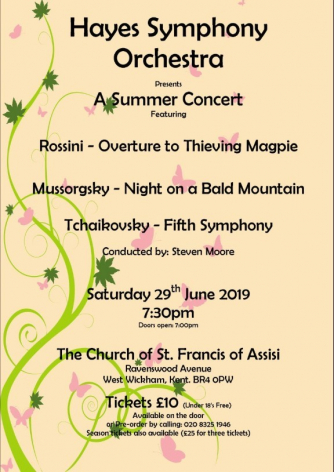Details
St Francis of Assisi Church
Ravenswood Ave
West Wickham
London
BR4 0PW
England
Programme
Gioachino Rossini – La Gazza Ladra (The Thieving Magpie): Overture
Modest Mussorgsky – Night on Bald Mountain
~ Interval ~
Pyotr Tchaikovsky – Symphony no.5 in E minor, Op.64
Performers
Stephen Moore – Conductor
Lynn Cook – Leader
Hayes Symphony Orchestra
Other concerts in this Series (+)
Programme Note
Gioacchino Rossini (1792-1868)
OVERTURE TO “THE THIEVING MAGPIE” (1817)
The most popular opera composer of his generation, the Italian Rossini composed no less than 39 of them before he retired at the age of 36, then settling in Paris where he lived comfortably - a noted wit, a generous host to many artistic and literary figures, and a passionate gourmet chef (yes, Tournedos Rossini was his invention). The opera “The Thieving Magpie” has a typically complicated plot, involving some missing silverware. It’s hardly ever performed in full these days, but its sparkling overture (notable for its use of snare drums) deserves its popularity, and contains his trademark device of building a climax, which earned him the affectionate nickname “Signor Crescendo”.
Modest Mussorgsky (1839-1881)
NIGHT ON BALD MOUNTAIN (1867)
Mussorgsky was one of the great originals of Russian music. His musical voice isn’t highly sophisticated like Tchaikovsky’s, but has a rough authenticity about it, looking to Russian folk music for its melody, to the sounds of Russian speech for its rhythms, and to Russian history and folklore for its inspiration. This tone poem, famous as an orchestral showpiece, depicts a wild nocturnal witches’ sabbath on a mountain top - it’s often called “Night on a Bare Mountain”, though the proper title comes from the name “Bald Mountain”. To be strictly accurate, this piece as we always hear it today was skilfully recomposed after Mussorgsky’s death by his friend Rimsky Korsakov, working from Mussorgsky’s original fragments and sketches - but it’s none the less brilliantly colourful and exciting for that.
Pyotr Ilyich Tchaikovsky (1840-1893)
SYMPHONY NO.5 IN E MINOR OPUS 64 (1888)
Tchaikovsky’s supreme talent for unforgettable melody, rich orchestral colour and dramatic excitement made him not only the ideal composer of ballet but also one of the world’s great symphonists. Like his fourth and sixth symphonies, No.5 is a large-scale work - about 50 minutes long - and like them is in the minor key, which gives them a tragic, melancholic power that is typically Russian.
No.5 opens with a mournful theme with a slow tread; this is a “motto” theme, which recurs at key points in the three other movements and gives the work a strong feeling of unity. After the passion of the first movement, the second opens with solemn, hymn-like chords, before the horn introduces one of Tchaikovsky’s most famous tunes. The “motto” theme recurs in the middle of the movement, and then again after a great climax towards the end.
The third movement is a “scherzo”, but not the usual boisterous kind; instead Tchaikovsky the master of ballet gives us a graceful waltz, with a notable contribution by the bassoon; the middle section (or “trio”) features lively running figures on the strings. Towards the end the rhythm of the “motto” theme appears like a ghost, as if to remind us Fate isn’t far away.
The finale is a riot of colour and excitement - it begins with the “motto”, this time in the major key, and the theme reappears yet again amid the blaze of triumph at the end of the symphony. No.5 has always been one of Tchaikovsky’s most popular works, but especially so in Russia during the horrors of the second world war, when it seemed perfectly to symbolise “victory through strife”.

 Your events at Classical Events
Your events at Classical Events

